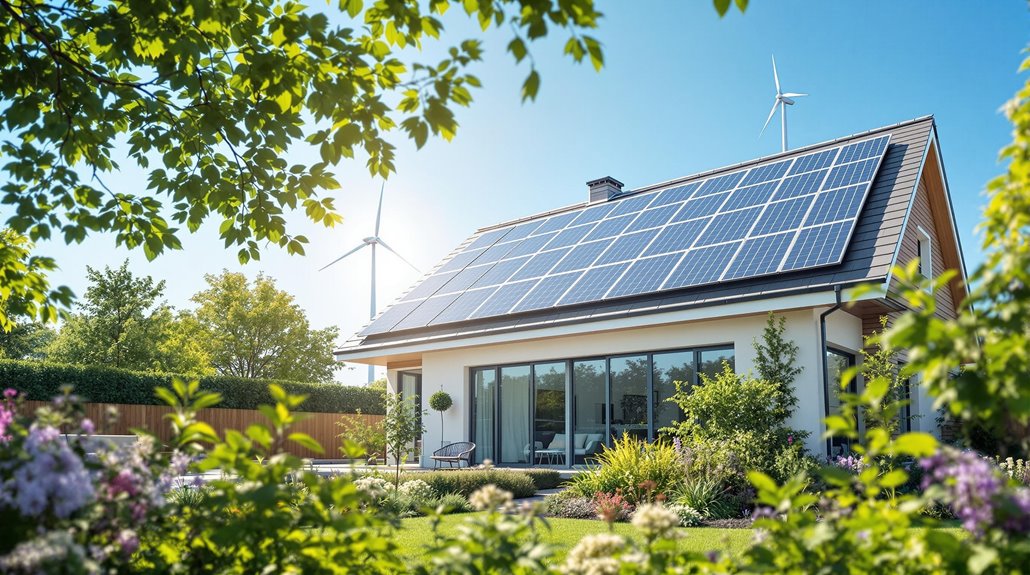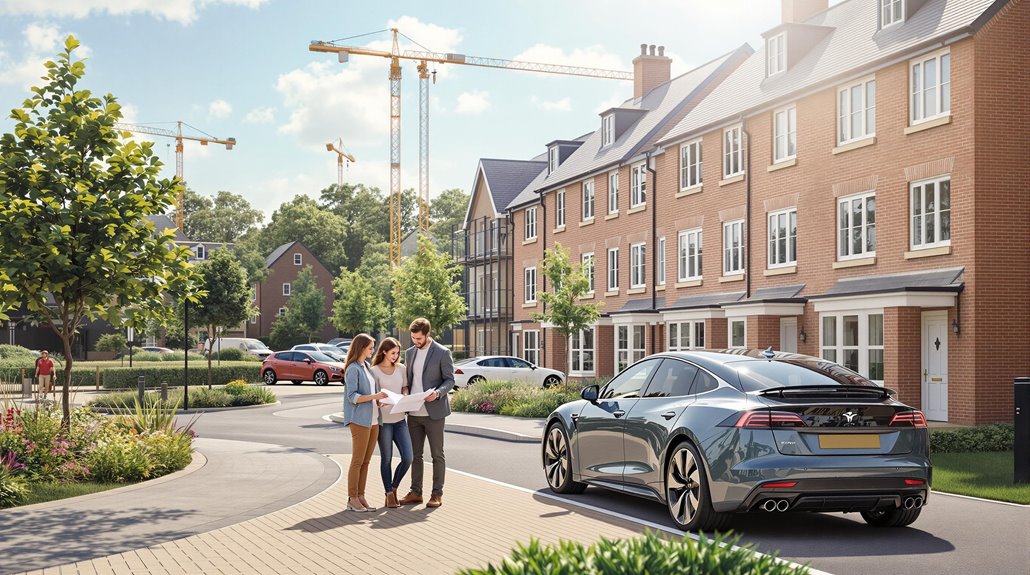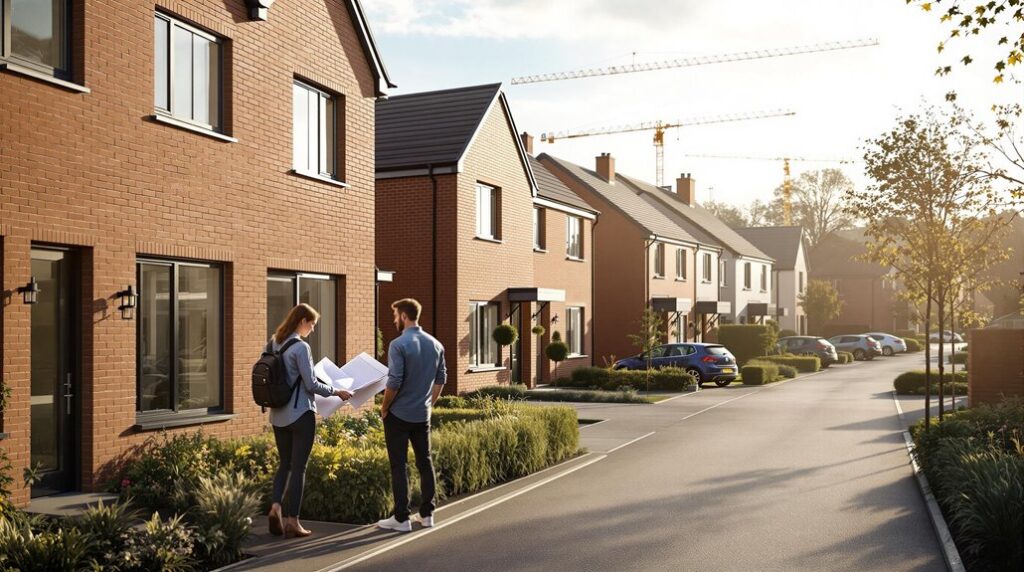I’ve been analyzing the new build market for 2025, and there’s a clear divide between what developers promise and what buyers actually experience. You’ll find impressive energy ratings and sleek modern features, but scratch beneath the surface and construction quality concerns emerge regularly. The financial implications aren’t straightforward either—while lower running costs sound appealing, the premium purchase prices and potential defect remediation costs complicate the investment equation. The reality might surprise you.
Key Takeaways
- New builds offer significant energy savings with £989 lower annual heating costs and 65% reduced carbon emissions compared to older homes.
- Construction quality remains problematic, with 93.7% of buyers reporting defects including plumbing, electrical, and insulation issues.
- Build costs range £1,750-£3,200 per m², with premium 3-bedroom houses costing around £345,085 including specifications.
- New builds qualify for Help to Buy schemes and warranties unavailable for resale properties, plus meet future regulatory standards.
- Limited supply of 124,000 expected completions creates premiums but strong appreciation potential of 7-10% annually in urban areas.
Energy Efficiency and Environmental Benefits of New Build Homes

When considering a new build home, energy efficiency stands as one of the most compelling advantages you’ll encounter. I’ve found that 88% of new domestic dwellings achieved EPC A or B ratings in Q1 2025, compared to under 5% of older homes. This translates to real savings—you’ll pay around £800 annually for heating, lighting, and hot water versus £1,789 for older properties. Furthermore, many new builds incorporate MVHR systems, which enhance indoor air quality while maintaining energy efficiency.
The environmental impact is equally impressive. New builds emit just 1.22 tonnes of carbon annually, 65% less than older homes at 3.51 tonnes. With the Future Homes Standard mandating 75-80% lower carbon emissions, you’re investing in property that meets tomorrow’s regulations today. The transition period for new building regulations ended on 15 June 2023, introducing enhanced standards for energy performance and electric vehicle charging points. Modern construction methods and superior insulation make these efficiency gains achievable consistently.
Modern Design Features and Contemporary Living Spaces
Beyond energy savings and environmental benefits, new build homes showcase cutting-edge design features that redefine how we live and work. I’ve noticed developers prioritizing flexible spaces with sliding panels and movable walls that transform rooms from home offices to family zones instantly. You’ll find biophilic design elements everywhere—green walls, skylights, and natural materials like reclaimed wood creating calming environments that connect you to nature. Incorporating natural light in these designs enhances the overall ambiance and creates a more inviting atmosphere.
The minimalist white trend is fading, replaced by bold Art Deco revival features with geometric patterns and statement ceilings. Sustainable construction methods use timber and renewable materials while maintaining durability. Most importantly, these designs center around your wellbeing. Acoustic considerations, ergonomic layouts, and natural light prioritize mental health, creating spaces that actually support how you want to live today. Smart home technology now integrates seamlessly through hidden speakers and app-controlled systems that enhance daily convenience without visual clutter.
Financial Costs and Investment Potential in 2025

While these modern design features create appealing living spaces, they come with substantial financial implications that’ll shape your investment decision. I’ll break down the key costs you’re facing in 2025.
Build costs range from £1,750 to £3,200 per m², averaging £2,387.50 nationally. You’re looking at £284,346 for a basic-spec 3-bedroom house, rising to £345,085 for premium specifications. Don’t forget the recommended 15% contingency for unexpected expenses.
Location dramatically impacts your budget. Urban areas like London command 20-30% higher costs, while rural builds offer lower entry points. You’ll benefit from zero-rated VAT on structural elements, though professional fees aren’t reclaimable. Additionally, new builds often feature energy-efficient designs, which can lead to long-term savings on utility bills.
Investment-wise, urban properties deliver 7-10% annual appreciation versus 3-5% rurally, but Labour’s housing pledge may inflate material costs. The largest expense component is your external wall structure, which typically accounts for 19.5% of your total build cost.
Construction Quality Issues and Common Defects
The statistics paint a stark picture: 93.7% of new build buyers report problems with their properties, according to the Home Builders Federation‘s latest survey. You’re not alone if you’ve experienced these issues.
I’ve seen the most common defects firsthand: snagging problems like poor plastering and ill-fitting doors dominate complaints. Plumbing, electrical, and insulation deficiencies consistently rank among top post-purchase issues. Material failures and workmanship errors remain the primary culprits. Conducting a new build survey can help identify these issues before finalizing your purchase.
Fire-safety cladding presents serious concerns, with over 2,600 social buildings confirmed to have life-critical defects. Only 25% of high-risk structures have completed remediation, leaving many residents in limbo.
The construction industry’s struggles are evident—quality indices hit 39.3, marking five consecutive monthly declines. Developer accountability gaps persist, with repair activity actually decreasing by 1.2% despite rising defect prevalence. Industry-wide challenges including skills shortages continue to impact construction quality and timely completion of projects.
Market Outlook and Practical Considerations for Buyers

Despite quality concerns plaguing the sector, new build markets present compelling opportunities if you understand the economic landscape ahead. I’m seeing projected price growth of 2-4% in 2025, accelerating to 5.5% by 2026. With only 124,000 new completions expected—one-third of government targets—supply constraints will drive premiums higher.
You’ll benefit from Help to Buy schemes and warranties that resale properties can’t match. Low-deposit mortgages are reaching post-2008 highs, though rates remain above 5%. The April stamp duty changes created investor urgency, signaling strong underlying demand. Additionally, the rise of Build to Rent developments is reshaping the housing market, offering tailored options for renters and enhancing investment viability.
My analysis shows new builds outperform in undersupplied regions long-term, offsetting higher entry costs. With rental inflation at 11% annually, you’re competing against cash-strapped renters who can’t save deposits fast enough. Mortgage approvals for house purchases rose above pre-pandemic levels by year-end, indicating growing market confidence despite ongoing affordability challenges.
Conclusion
I’d recommend carefully evaluating your priorities before choosing a new build. If you’re prioritizing energy efficiency and modern features, they’re worth considering despite higher upfront costs. However, don’t overlook potential construction defects and quality issues that could impact your investment. I suggest hiring an independent surveyor, researching the developer’s track record, and budgeting for potential remedial work. The decision ultimately depends on your risk tolerance and long-term housing goals.
References
- https://hoa.org.uk/advice/guides-for-homeowners/i-am-buying/new-build-vs-existing-home/
- https://www.youtube.com/watch?v=FltEyy0HdYw
- https://hoa.org.uk/advice/guides-for-homeowners/i-am-buying/is-now-a-good-time-to-buy-a-house/
- https://ukestates.uk/the-pros-and-cons-of-buying-a-new-build-vs-an-older-property/
- https://www.mfsuk.com/blog/new-build-good-investment/
- https://www.gov.uk/government/statistics/housing-supply-indicators-of-new-supply-england-january-to-march-2025/housing-supply-indicators-of-new-supply-england-january-to-march-2025
- https://www.ecology.co.uk/hub/why-energy-performance-new-homes-matters/
- https://www.hbf.co.uk/news/energy-performance-of-new-homes-watt-a-save-data/
- https://www.gov.uk/government/statistics/energy-performance-of-building-certificates-in-england-and-wales-january-to-march-2025/energy-performance-of-buildings-certificates-statistical-release-january-to-march-2025-england-and-wales
- https://commonslibrary.parliament.uk/research-briefings/cbp-9889/

